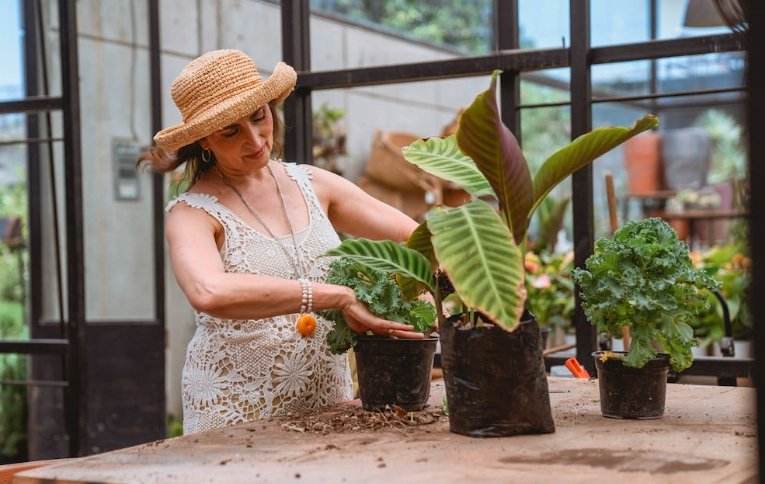Indoor gardening is becoming an increasingly popular trend, as more people look for ways to bring the outdoors in and enjoy the beauty and benefits of having plants indoors. Not only do plants add a touch of beauty and tranquility to any home, but they also help to purify the air and reduce stress. As such, having an indoor garden is a great way to bring a little bit of nature into your home and reap the many benefits that plants have to offer.
When it comes to starting an indoor garden, there are a few things to consider. First, you’ll need to choose the right plants for your space and make sure to provide them with the amount of light and water that they need to flourish. Some of the best plants for indoor gardening include fiddle-leaf figs, philodendrons, and cacti. These plants are easy to care for and ideal for brightening up any room. Additionally, if you’d like to bring a bit of greenery to your bathroom, plants such as peace lilies and anthuriums are perfect for the more humid environment.
Once you’ve selected your plants, it’s important to give them the proper care and attention that they need to thrive. This includes ensuring that they have the right amount of light, water, and soil, as well as providing them with a regular fertilizing schedule. Additionally, it’s important to remember to rotate your plants occasionally to ensure they get even coverage of light. With a little bit of care, you can have an indoor garden that is both beautiful and functional.
Choosing the Right Plants
Best Plants for Indoor Gardening
1. Common Options: Houseplants, succulents, and herbs are all common options for indoor gardens. Houseplants are well-suited to a variety of conditions and provide a splash of color and life to a room. Succulents require less water than other plants, making them easier to care for, while herbs are a popular choice for those looking to grow their own food.

2. Considerations: When selecting a plant for an indoor garden, it is important to consider the size of the space, the amount of sunlight available, and the temperatures of the room. Additionally, the amount of maintenance required may vary depending on the type of plant.
Factors to Consider when Choosing Plants
1. Light Requirements: Different plants have different light requirements, so it is important to select plants that can thrive in the amount of light available in the space. Placing plants in direct sunlight can cause them to become scorched, so it is important to choose plants that can thrive in the amount of light available.
2. Temperature: The temperature of the room is also an important factor to consider when selecting plants. Some plants prefer cooler temperatures, while others can tolerate higher temperatures.
Matching Plants to your Indoor Conditions
1. Research: Doing research on different plants and their needs is essential when selecting plants for an indoor garden. Plants that require too much sunlight or require frequent watering may not be well-suited to the space.
2. Climate-appropriate Plants: It is important to select plants that are native to the climate and can thrive in the specific conditions of the space. Knowing the climate and the specific needs of each plant is the key to creating a successful indoor garden.
Creating a Color Scheme
1. Colorful Plants: When creating an indoor garden, it is important to select plants that will provide a splash of color and life to the space. Choosing colorful plants that will contrast and complement each other will help to create a vibrant and inviting space.
2. Contrast and Complement: Combining plants with different colors and textures will create a visually interesting space. Selecting plants that contrast with each other, such as a large green leafy plant and a small flowering one, will create a unique and eye-catching garden.
Growing and Caring for Indoor Plants
Lighting Requirements
Indoor plants need adequate light for healthy growth and flowering. The amount of light an indoor plant needs will depend on the type of plant and its positioning in the home. Generally, indoor plants should be placed near a window, where they can receive natural light, or in a well-lit room. Some plants may require supplemental lighting, such as fluorescent lights, to receive the right amount of light.
Soil and Drainage
The type of soil used for indoor plants should depend on the type of plant. Potting mixes that are specially formulated for indoor plants are available in most gardening stores. Cacti and succulents prefer a soil that drains quickly, and plants that require more moisture should be planted in a soil that retains more water. All plants should have containers with good drainage holes to prevent root rot.
Watering and Fertilizing
Watering indoor plants is important for keeping them healthy and growing. The amount of water needed will depend on the type of plant and the conditions in the home. In general, it is best to water plants when the soil begins to dry out. Over-watering can cause root rot and other problems. Fertilizing indoor plants is also important for healthy growth. Most plants need to be fertilized every two to four weeks. Organic fertilizers are recommended for indoor plants, as they are safer for the environment.
Pruning and Grooming
Indoor plants should be pruned and groomed regularly to keep them healthy and looking their best. Pruning is important for controlling the size and shape of plants, as well as for removing dead or diseased branches and leaves. Grooming includes removing dead leaves and flowers, and cleaning the leaves to keep them free of dust and debris. Grooming is also important for promoting healthy growth and flowering.
Indoor Garden Design
1. Choosing the Right Containers: Before creating an indoor garden, it is essential to select the right containers for the plants. Containers should be selected based on the size of the plants, their soil requirements, and their water needs. The containers should be chosen to be aesthetically pleasing, as well as durable and strong enough to hold the weight of the soil and plants. A variety of materials can be used for the containers, such as plastic, ceramic, terracotta, and metal. It is important to select the right size and style that will best accommodate the plants and give the garden a beautiful look.
2. Plant Placement and Arrangement: Strategically placing and arranging the plants is key to creating a beautiful indoor garden. It is important to ensure that the plants have enough space to grow and receive adequate sunlight. The plants should be arranged in a way that creates a pleasing visual effect and highlights the different textures and colors of the plants. Different heights of plants can be used to create a layered look, while the arrangement of the plants should be symmetrical and balanced.
3. Incorporating Different Plant Textures and Heights: Using different textures and heights of plants will create a more interesting and eye-catching indoor garden. Different plants have unique textures that can be used to create visual interest, such as the soft leaves of ferns or the spiky leaves of succulents. Incorporating different heights of plants, such as tall and trailing plants, will also help to create a layered effect. Additionally, using plants with different colors and shapes can create a more varied and intriguing display.
4. Creating a Themed Indoor Garden: When creating an indoor garden, it is possible to incorporate a theme to make the design even more special. A theme can be based on a particular color scheme, such as pink and green, or a specific style, such as a beach-themed garden. Incorporating a theme into the design of the garden can add a unique and personal touch. Additionally, the themed elements can be used to complement the plants and create a cohesive look.
Common Indoor Plant Problems and Solutions
Identifying and Correcting Plant Issues
Identifying and correcting plant issues is an important part of caring for any indoor plant. Knowing the signs of a plant not doing well is the first step to solving any issue. Common signs of problems include yellowing or wilting leaves, drooping stems, and stunted growth. These issues can be caused by many things, such as improper watering, lack of nutrients, or poor soil drainage. In order to identify and correct plant issues, it is important to first determine the cause of the issue. Once the cause is determined, a solution can be found. Solutions might include repotting the plant, changing the soil, or adjusting the watering schedule.
Preventing and Treating Pests and Diseases
Pests and diseases can cause a lot of damage to indoor plants. The best way to prevent these issues is to practice good hygiene, such as regularly cleaning the leaves and keeping the soil healthy. If pests or diseases are spotted, they should be treated immediately. Common pest treatments include insecticidal soaps, neem oil, and sticky traps. Diseases can be treated with fungicides or by removing and destroying any infected parts of the plant.
Dealing with Environmental Stress
Environmental stress can also cause problems for indoor plants. Factors such as temperature, humidity, and light can all have an impact on the health of a plant. In order to deal with environmental stress, it is important to provide the plant with the correct amount of light, water, and nutrients. Additionally, the temperature of the room should be monitored to ensure that it is not too hot or too cold for the plant. Humidity can also be an issue, so it is important to make sure the air is not too dry. Finally, it is a good idea to regularly check the soil for signs of stress, such as dryness or discoloration.

Advanced Techniques for Indoor Gardening
Propagation and Transplanting
Propagation is a process of creating a new plant using existing plants. It involves taking a cutting from a stem or root of an existing plant and planting it into a pot or tray with soil or other medium to promote new growth. Transplanting is the process of moving a plant from one pot or tray to another, usually to a larger pot or tray to facilitate growth. Both of these methods are important in indoor gardening, as they allow gardeners to quickly grow more plants without having to purchase new ones. Propagation and transplanting can be done using a variety of methods, including cuttings, layering, division, and grafting.
Air Layering
Air layering is a method of propagating plants that involves taking a branch or stem from an existing plant and wrapping it in moistened sphagnum moss, then wrapping it in plastic to hold the moisture in. The branch is then left to develop roots, which can then be cut off and planted in a pot or tray with soil. This method is often used to propagate hard-to-root plants, and it can be used to increase the number of plants quickly and easily.
Hydroponic and Aeroponic Systems
Hydroponic and aeroponic systems are popular methods of indoor gardening, as they allow plants to grow without the need for soil. In a hydroponic system, plants are grown in a nutrient-rich water solution, while in an aeroponic system, the plants are suspended in the air and sprayed with a nutrient-rich mist. Both systems provide plants with the nutrients they need to grow and thrive, and are great for growing plants in a minimal amount of space.
Conclusion
Indoor gardening allows you to bring the beauty and health benefits of the outdoors into your home. With the right plants, you can create a lush, vibrant indoor garden that will bring life and color to your home. You can choose from a wide variety of plants that will thrive indoors, including low-maintenance succulents, flowering plants, and foliage plants. With a little bit of research and care, you can create a stunning and relaxing indoor garden that will benefit your home and your health. From air-purifying plants to plants that help you relax and de-stress, there are a wide variety of options to choose from. Indoor gardening is an easy and enjoyable way to bring the outdoors in and add beauty to your home.
FAQs
1. What are the best plants for indoor gardening?
The best plants for indoor gardening include succulents, air plants, spider plants, snake plants, peace lilies, aloe vera, pothos, chinese evergreens, dracaenas, and fiddle leaf figs.
2. What are the benefits of indoor gardening?
Indoor gardening offers many benefits such as improved air quality, stress relief, mental stimulation, and a natural way to decorate your home.
3. How do I choose the right plant for my home?
When choosing plants for your home, consider factors such as your light availability, temperature, humidity, and the amount of care needed.
4. How do I care for my indoor plants?
Proper care for indoor plants includes appropriate watering, pruning, and fertilizing. Additionally, make sure they receive adequate light and temperature.
5. What is the best soil for indoor plants?
The best soil for indoor plants is a well-draining potting mix that is specifically formulated for indoor plants.
6. Can indoor plants help purify the air?
Yes, certain indoor plants such as aloe vera, English ivy, peace lilies, and spider plants are known to help purify the air.
7. What are the best plants that are easy to maintain?
Succulents, air plants, spider plants, snake plants, and pothos are all known to be easy-care plants that require minimal maintenance.
8. How often should I water my indoor plants?
The answer to this question will depend on the type of plant you have. Generally speaking, most indoor plants should be watered when the soil is dry to the touch.
9. What should I do if my indoor plants get too much light?
If your plants are getting too much light, move them to a spot with indirect sunlight or provide a sheer curtain to filter the light.
10. What is the best way to propagate my indoor plants?
Propagation methods for indoor plants will depend on the type of plant. Generally, propagation can be done through cuttings, division, or layering.


















